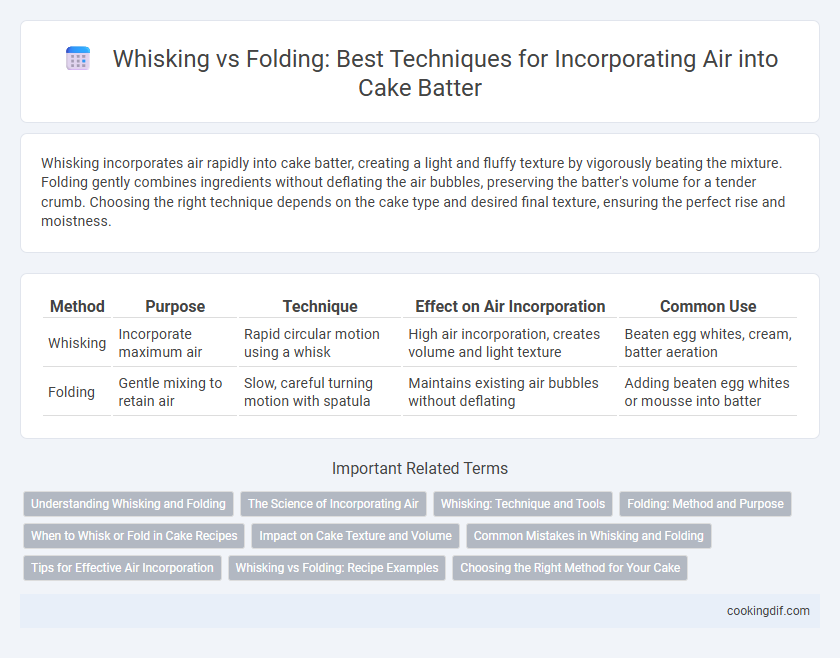Whisking incorporates air rapidly into cake batter, creating a light and fluffy texture by vigorously beating the mixture. Folding gently combines ingredients without deflating the air bubbles, preserving the batter's volume for a tender crumb. Choosing the right technique depends on the cake type and desired final texture, ensuring the perfect rise and moistness.
Table of Comparison
| Method | Purpose | Technique | Effect on Air Incorporation | Common Use |
|---|---|---|---|---|
| Whisking | Incorporate maximum air | Rapid circular motion using a whisk | High air incorporation, creates volume and light texture | Beaten egg whites, cream, batter aeration |
| Folding | Gentle mixing to retain air | Slow, careful turning motion with spatula | Maintains existing air bubbles without deflating | Adding beaten egg whites or mousse into batter |
Understanding Whisking and Folding
Whisking rapidly agitates the batter or cream to incorporate maximum air, resulting in a light and fluffy texture essential for meringues and sponge cakes. Folding gently combines ingredients without deflating the mixture, preserving the trapped air crucial for delicate batters like chiffon or mousse. Mastering the difference between whisking and folding ensures optimal volume and texture in cake preparation.
The Science of Incorporating Air
Whisking incorporates air into cake batter by rapidly agitating the mixture, creating tiny air bubbles that expand during baking, resulting in a lighter texture. Folding gently combines ingredients, preserving the delicate air pockets formed during whisking to maintain volume and prevent deflation. Understanding the science of air incorporation is crucial for achieving cakes with optimal rise and fluffy crumb structure.
Whisking: Technique and Tools
Whisking involves rapidly beating ingredients with a wire whisk or electric mixer, creating a stable foam by incorporating air bubbles into the mixture. This technique is essential for achieving light, airy textures in cakes, especially in meringues, sponge cakes, and whipped creams. Proper whisk selection, such as balloon whisks for maximum aeration, significantly influences the volume and consistency of the final baked product.
Folding: Method and Purpose
Folding is a gentle mixing technique designed to incorporate air without deflating the batter, preserving the delicate structure of whipped ingredients like egg whites or cream. It involves carefully lifting and turning the mixture using a spatula or spoon along the side of the bowl in repeated motions. This method maintains the light, airy texture essential for cakes such as souffles, chiffon, and sponge cakes.
When to Whisk or Fold in Cake Recipes
Whisking is essential in cake recipes requiring maximum aeration, such as sponge or chiffon cakes, where egg whites or batter must become light and fluffy to provide volume. Folding is preferred for delicate mixtures to gently incorporate ingredients without deflating the aerated batter, commonly used when combining whipped egg whites into heavier batters. Understanding when to whisk versus fold ensures the desired cake texture and rise, optimizing crumb structure and lightness.
Impact on Cake Texture and Volume
Whisking vigorously incorporates air into the batter, resulting in a lighter, fluffier cake with increased volume. Folding gently blends ingredients without deflating trapped air, preserving the cake's delicate crumb and moist texture. Proper technique in whisking or folding directly influences the cake's rise and crumb structure, ensuring optimal texture and volume.
Common Mistakes in Whisking and Folding
Over-whisking cake batter can cause it to become dense and tough due to gluten overdevelopment, while under-whisking prevents sufficient air incorporation, resulting in a flat cake. Common folding mistakes include stirring too vigorously, which deflates the air bubbles, and uneven folding that causes inconsistent texture. Proper technique requires gentle, consistent folding and monitoring whisking time to maintain optimal air retention for a light, fluffy cake crumb.
Tips for Effective Air Incorporation
Whisking rapidly agitates cake batter, creating numerous tiny air bubbles essential for light and fluffy texture, while folding gently combines ingredients without deflating trapped air. Use a balloon whisk for whisking to maximize oxygen incorporation, and employ a spatula or large spoon when folding, working carefully to preserve aeration. Maintain consistent speed during whisking and fold in slow, deliberate strokes to achieve optimal volume and moist crumb structure.
Whisking vs Folding: Recipe Examples
Whisking incorporates air rapidly by beating ingredients like egg whites or cream to create volume, essential for recipes such as meringues and sponge cakes. Folding gently combines delicate mixtures without deflating air bubbles, crucial for souffles and chiffon cakes. Using the correct technique ensures optimal texture and rise in baked goods.
Choosing the Right Method for Your Cake
Whisking incorporates maximum air into cake batter, ideal for sponge or chiffon cakes that require a light, airy texture. Folding gently combines delicate ingredients like whipped egg whites or cream, preserving the trapped air to maintain volume and fluffiness. Selecting whisking or folding depends on the cake type and batter consistency to achieve optimal rise and texture.
Whisking vs Folding for incorporating air Infographic

 cookingdif.com
cookingdif.com